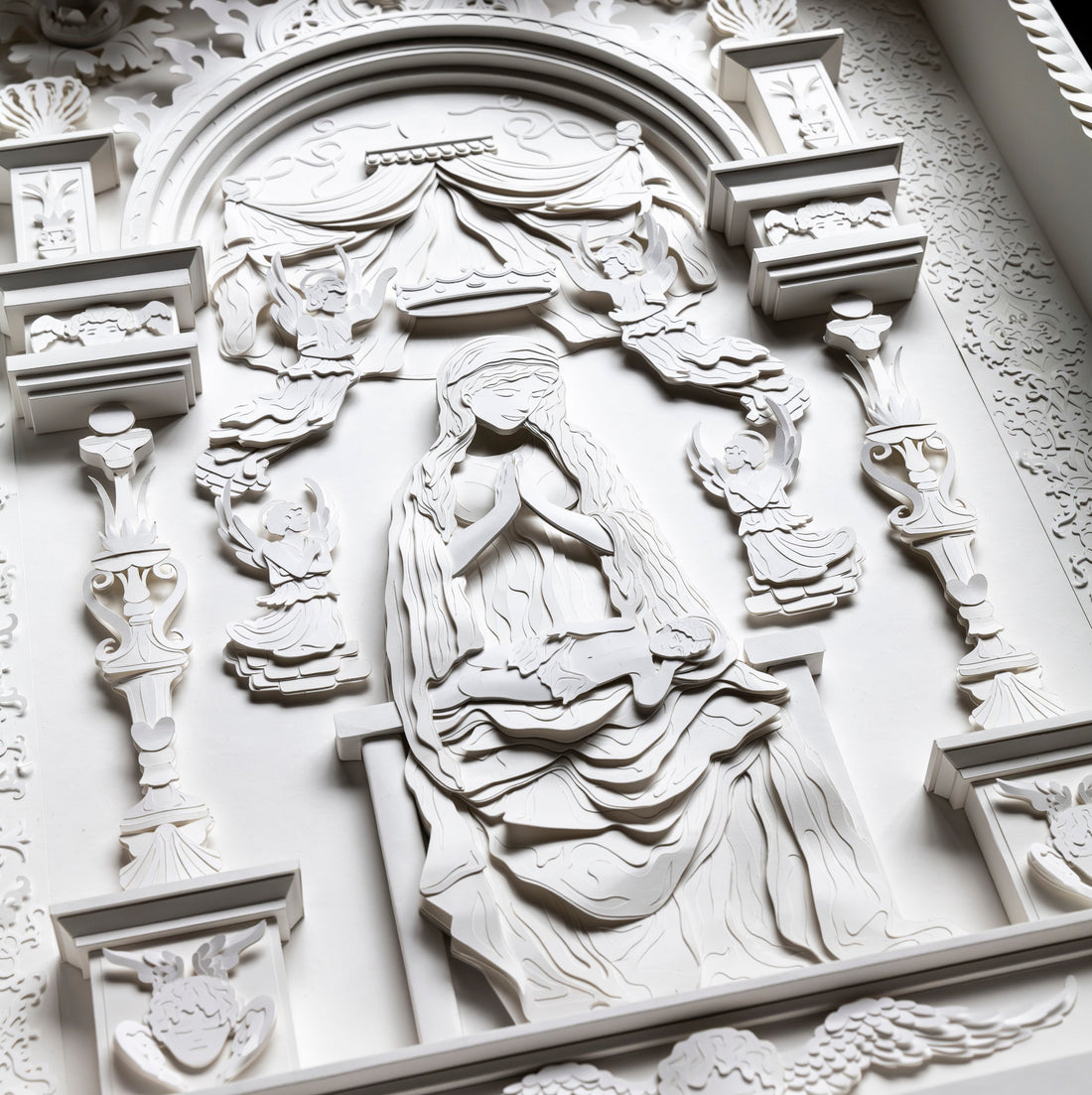
The (Paper) Craft: Ghost Objects at Leighton House
Some ghosts do not rattle chains—they rustle. At Leighton House, they stir quietly, not in the shadows but in plain sight, taking shape in white paper. During the museum’s centenary year, an unusual homecoming has taken place. Ghost Objects: Summoning Leighton’s Lost Collection follows a single question: what happens to the things we lose, and can they ever return?
When Frederic Lord Leighton died in 1896, the treasured objects that once filled his studio and home began to scatter. Some slipped into private collections, others vanished without trace into auction rooms. A century later, Dutch paper artist Annemarieke Kloosterhof has been invited to bring four of these missing objects back through a kind of summoning. One that draws from memory, patience and craft.
 Annemarieke Kloosterhof at Leighton House ©RBKC. Image Jaron James copy
Annemarieke Kloosterhof at Leighton House ©RBKC. Image Jaron James copy
They return now not as replicas, but as apparitions: life-sized sculptures crafted entirely from white paper. Through layering, embossing and thousands of hand-cut fragments, Kloosterhof transforms a fragile material into something that holds remarkable presence. Each piece feels suspended between worlds—precise in form, yet dream-like, as if time has thinned and allowed the past to reappear.
The story unfolds room by room. In Leighton’s studio, a 15th-century Italian tabernacle shrine (lead image) originally carved in gilded wood rises again, this time from more than 8,000 pieces of hand-cut paper. Its Gothic tracery and Islamic-inspired details echo Leighton’s fascination with global craftsmanship and the cross-pollination of cultures.
 Klismos Chair, recreated by artist Annemarieke Kloosterhof for Ghost Objects at Leighton House ©RBKC. Image Jaron James
Klismos Chair, recreated by artist Annemarieke Kloosterhof for Ghost Objects at Leighton House ©RBKC. Image Jaron James
In the Silk Room, an ebonised klismos chair and stool stand as if waiting to be used. They once appeared in Leighton’s paintings, including The Dance, yet no photographs of the originals survive. To rebuild them, Kloosterhof took on the role of detective—measuring proportions from paintings, reading clues in brushstrokes and reverse-engineering scale from the room they once furnished.
 Inlaid Cabinet, recreated by artist Annemarieke Kloosterhof for Ghost Objects at Leighton House ©RBKC. Image Jaron James
Inlaid Cabinet, recreated by artist Annemarieke Kloosterhof for Ghost Objects at Leighton House ©RBKC. Image Jaron James
The drawing room hosts a cabinet from Northern Italy, its history still disputed. Was it a genuine seventeenth-century piece or a nineteenth-century reproduction designed to look older? Kloosterhof keeps the mystery alive. With papers of varying weight and density, she mimics carved ebony and engraved ivory, letting shadow and texture become part of the storytelling.
 Brass Jardinière, recreated by artist Annemarieke Kloosterhof for Ghost Objects at Leighton House ©RBKC. Image Jaron James
Brass Jardinière, recreated by artist Annemarieke Kloosterhof for Ghost Objects at Leighton House ©RBKC. Image Jaron James
Then, on the staircase, a dramatic resurrection: a towering Anglo-Indian jardinière crowned with a paper palm tree, over three metres tall. Long misidentified as Indian craftsmanship, it is now understood as a hybrid object made for Western collectors seeking an exotic ideal. Kloosterhof builds its base from papier-mâché using offcuts from the other sculptures, binding the four works together like pages in the same unfinished history.
Known for installations for Bridgerton, Viktor & Rolf and Hermès, Kloosterhof approaches this project like a summoning. These sculptures are not simply reconstructions but careful hauntings, carrying the presence of things no longer here. In their spectral whiteness, they show how craft can become a form of time travel, holding open a doorway between what was and what remains.
-
Further Information:
Ghost Objects: Summoning Leighton’s Lost Collection is open now until 1 March 2026 at Leighton House, 12 Holland Park Rd, London, W14 8LZ
-
-
Image Credits:
Lead: Tabernacle, recreated by artist Annemarieke Kloosterhof for Ghost Objects at Leighton House ©RBKC. Image Jaron James
All further images as credited in photo captions
